-
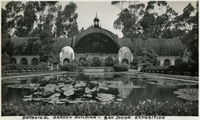 McCarthy Album 10, Photograph 072
McCarthy Album 10, Photograph 072 Caption: "Botanical Garden Building - San Diego Exposition," 1935, shows the Botanical Building and Conservatory with reflecting pool that featured lilies, begonias, fuchsias, and a variety of ferns at the California-Pacific International Exposition.
-
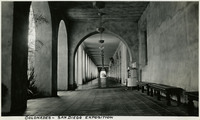 McCarthy Album 10, Photograph 071
McCarthy Album 10, Photograph 071 Caption: "Colonades [sic] - San Diego Exposition," 1935.
-
 McCarthy Album 10, Photograph 070
McCarthy Album 10, Photograph 070 Caption: "Night Scene - San Diego Exposition," 1935, a night scene at San Diego's California-Pacific International Exposition shows the Arch of the Future with its multi-colored lights built within the Plaza del Pacifico.
-
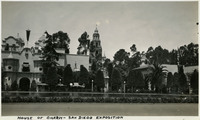 McCarthy Album 10, Photograph 069
McCarthy Album 10, Photograph 069 Caption: "House of Charm - San Diego Exposition," 1935.
-
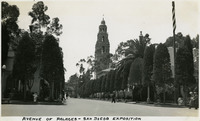 McCarthy Album 10, Photograph 068
McCarthy Album 10, Photograph 068 Caption: "Avenue of Palaces - San Diego Exposition," 1935.
-
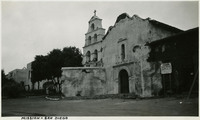 McCarthy Album 10, Photograph 067
McCarthy Album 10, Photograph 067 Caption: "Mission-San Diego," c. 1935, shows Mission San Diego de Alcala, the first of twenty-one missions built by the Spanish Franciscans, and founded in 1769 by Father Junipero Serra.
-
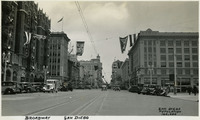 McCarthy Album 10, Photograph 066
McCarthy Album 10, Photograph 066 Caption: "Broadway San Diego, San Diego Population 160,000," c. 1935.
-
 McCarthy Album 10, Photograph 065
McCarthy Album 10, Photograph 065 Caption: "Pima Indian Children and their hut made from bush branches, Sacaton Indian Reservation, Sacaton, Arizona," c. 1935. Located south of Phoenix and including the town of Sacaton, the Gila River Indian Reservation is home to members of the Akimel O’odham (Pima) and the Pee-Posh (Maricopa) tribes. The reservation was established in 1859. Eighty years later, in 1939, Congress provided for the self-governance of the reservation via the Gila River Indian Community.
-
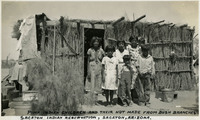 McCarthy Album 10, Photograph 064
McCarthy Album 10, Photograph 064 Caption: "Pima Indian Children and their hut made from bush branches, Sacaton Indian Reservation, Sacaton, Arizona," c. 1935. Located south of Phoenix and including the town of Sacaton, the Gila River Indian Reservation is home to members of the Akimel O’odham (Pima) and the Pee-Posh (Maricopa) tribes. The reservation was established in 1859. Eighty years later, in 1939, Congress provided for the self-governance of the reservation via the Gila River Indian Community.
-
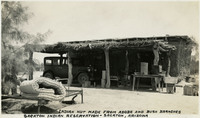 McCarthy Album 10, Photograph 063
McCarthy Album 10, Photograph 063 Caption: "Indian Hut Made from Adobe and Bush Branches, Sacaton Indian Reservation - Sacaton, Arizona," c. 1935. View of a small adobe building with a porch area across the length of the façade. The porch is sheltered by a low roof supported by tree trunks or thick tree branches and thatched with grass or sticks. Located south of Phoenix and including the town of Sacaton, the Gila River Indian Reservation is home to members of the Akimel O’odham (Pima) and the Pee-Posh (Maricopa) tribes. The reservation was established in 1859. Eighty years later, in 1939, Congress provided for the self-governance of the reservation via the Gila River Indian Community.
-
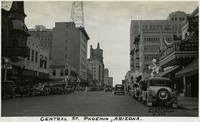 McCarthy Album 10, Photograph 062
McCarthy Album 10, Photograph 062 Caption: "Central Street, Phoenix, Arizona, Phoenix Population 51,000," c. 1935 shows a busy street scene in Phoenix, Arizona.
-
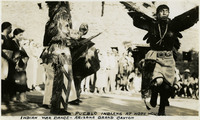 McCarthy Album 10, Photograph 061
McCarthy Album 10, Photograph 061 Caption: "Pueblo Indians at Hopi House, Indian War Dance-Arizona Grand Canyon," c. 1935
-
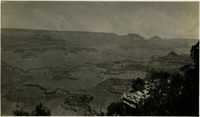 McCarthy Album 10, Photograph 060
McCarthy Album 10, Photograph 060 No Caption: A view of the Grand Canyon, c. 1935.
-
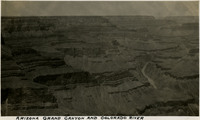 McCarthy Album 10, Photograph 059
McCarthy Album 10, Photograph 059 Caption: "Arizona Grand Canyon and Colorado River," c. 1935.
-
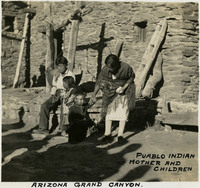 McCarthy Album 10, Photograph 058
McCarthy Album 10, Photograph 058 Caption: "Puablo [sic] Indian Mother and Child, Arizona Grand Canyon," c. 1935, shows a Pueblo Indian mother with three children.
-
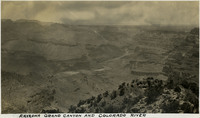 McCarthy Album 10, Photograph 057
McCarthy Album 10, Photograph 057 Caption: "Arizona Grand Canyon and Colorado River," c. 1935.
-
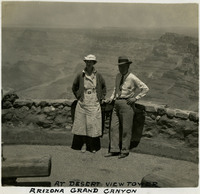 McCarthy Album 10, Photograph 056
McCarthy Album 10, Photograph 056 Caption: "At Desert View Tower Arizona Grand Canyon," c. 1935, shows Grace and William McCarthy at the top of the Desert View Watchtower.
-
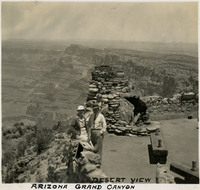 McCarthy Album 10, Photograph 055
McCarthy Album 10, Photograph 055 Caption: "Desert View Arizona Grand Canyon," c. 1935, shows William and Grace McCarthy looking out over the Grand Canyon from the top of the Desert View Watchtower.
-
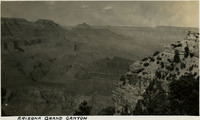 McCarthy Album 10, Photograph 054
McCarthy Album 10, Photograph 054 Caption: "Arizona Grand Canyon," c. 1935.
-
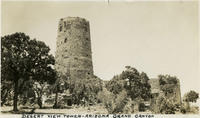 McCarthy Album 10, Photograph 053
McCarthy Album 10, Photograph 053 Caption: "Desert View Tower - Arizona Grand Canyon," c. 1935. The Desert View Watchtower, built in 1932, was designed by architect Mary Colter in the style of Ancestral Puebloan watchtowers.
-
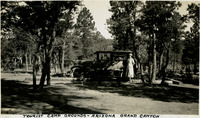 McCarthy Album 10, Photograph 052
McCarthy Album 10, Photograph 052 Caption: "Tourist Camp Grounds-Arizona Grand Canyon," c. 1935, shows Grace McCarthy standing near an automobile at a Grand Canyon campground.
-
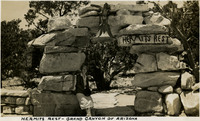 McCarthy Album 10, Photograph 051
McCarthy Album 10, Photograph 051 Caption: "Hermits Rest - Grand Canyon of Arizona," c. 1935, shows Grace McCarthy sitting under an archway made of large boulders, with a bell hanging down from the top center, and "Hermits Rest" spelled out on one of the rocks.
-
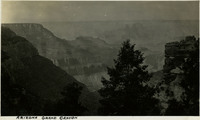 McCarthy Album 10, Photograph 050
McCarthy Album 10, Photograph 050 Caption: "Arizona Grand Canyon," c. 1935.
-
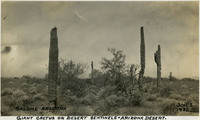 McCarthy Album 10, Photograph 049
McCarthy Album 10, Photograph 049 Caption: "Salome Arizona, Giant Cactus or Desert Sentinels - Arizona Desert. June 1, 1935."
-
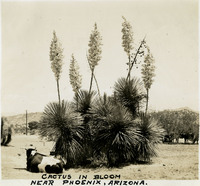 McCarthy Album 10, Photograph 048
McCarthy Album 10, Photograph 048 Caption: "Cactus in Bloom Near Phoenix, Arizona," c. 1935, shows a large cactus in bloom and a bull resting nearby.
-
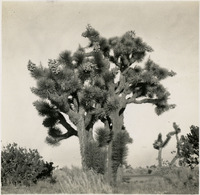 McCarthy Album 10, Photograph 047
McCarthy Album 10, Photograph 047 No Caption: A Joshua tree in bloom in the Arizona desert, c. 1935.
-
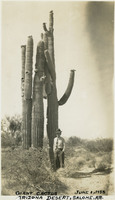 McCarthy Album 10, Photograph 046
McCarthy Album 10, Photograph 046 Caption: "Giant Cactus Arizona Desert, Salome, AR. June 1, 1935," shows William McCarthy standing next to a large cactus at Salome, Arizona.
-
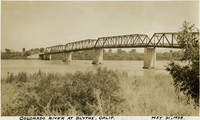 McCarthy Album 10, Photograph 045
McCarthy Album 10, Photograph 045 Caption: "Colorado River at Blythe, Calif. May 31, 1935."
-
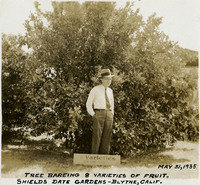 McCarthy Album 10, Photograph 044
McCarthy Album 10, Photograph 044 Caption: "Tree Bareing [sic] 8 Varieties of Fruit. Shields Date Gardens - Blythe, Calif. May 31, 1935," shows William McCarthy standing next to a tree that bears eight varieties of fruit.
-
 McCarthy Album 10, Photograph 043
McCarthy Album 10, Photograph 043 Caption: "Date Palm, Shields Date Gardens, Blythe, California, May 31, 1935," shows Grace McCarthy standing next to a date palm.
-
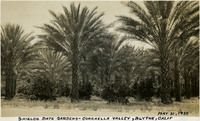 McCarthy Album 10, Photograph 042
McCarthy Album 10, Photograph 042 Caption: "Shields Date Gardens - Coachella Valley, Blythe, Calif. May 31, 1935." Date Palms at the Shields Date Gardens, which opened in 1924 at Blythe, California.
-
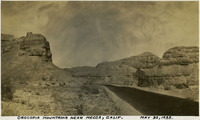 McCarthy Album 10, Photograph 041
McCarthy Album 10, Photograph 041 Caption: "Orocopia Mountains Near Mecca, Calif. May 30, 1935," shows an empty road traversing the Orocopia Mountains near Mecca, in Riverside County.
-
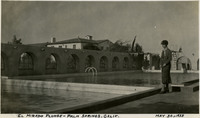 McCarthy Album 10, Photograph 040
McCarthy Album 10, Photograph 040 Caption: "El Mirado Hotel-Palm Springs, Calif. May 30, 1935." The Spanish Colonial-Revival style El Mirado Hotel at Palm Springs opened in 1927 and became one of the most fashionable resort destinations for powerful Hollywood studio heads and celebrities. Here Grace is seen posing at the edge of the hotel's famous "plunge."
-
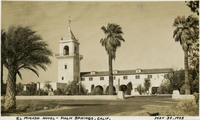 McCarthy Album 10, Photograph 039
McCarthy Album 10, Photograph 039 Caption: "El Mirado Hotel-Palm Springs, Calif. May 30, 1935." The Spanish Colonial-Revival style El Mirado Hotel at Palm Springs opened in 1927 and became one of the most fashionable resort destinations for powerful Hollywood studio heads and celebrities.
-
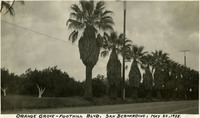 McCarthy Album 10, Photograph 038
McCarthy Album 10, Photograph 038 Caption: "Orange Grove - Foothill Blvd. San Bernardino, May 30, 1935." Shows an orange grove behind a row of stately palms on Foothill Blvd., also known as Route 66.
-
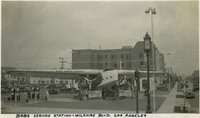 McCarthy Album 10, Photograph 037
McCarthy Album 10, Photograph 037 Caption: "Bobs Service Station - Wilshire Blvd. Los Angeles," c. 1935, shows Bob Spencer's Mobil gas service station, which was built around a grounded Fokker F32, whose wings served as a canopy for the fueling stations.
-
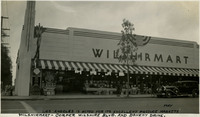 McCarthy Album 10, Photograph 036
McCarthy Album 10, Photograph 036 Caption: "Wilshirmart - Corner Wilshire Blvd. and Doheny Drive. Los Angeles is Noted for its Excellent Produce Markets," c. 1935.
-
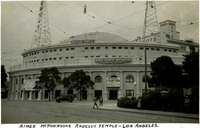 McCarthy Album 10, Photograph 035
McCarthy Album 10, Photograph 035 Caption: "Aimee McPherson's Angeles Temple- Los Angeles," c. 1935. Aimee Semple McPherson, also known as Sister Aimee was a Canadian-American Pentecostal evangelist and media celebrity in the 1920s and 1930s, famous for her theatrical sermons and claims of healing the sick, and for founding the Foursquare Church.
-
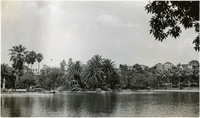 McCarthy Album 10, Photograph 034
McCarthy Album 10, Photograph 034 No Caption: Shows an unidentified pond or lake in a Los Angeles area park, c. 1935.
-
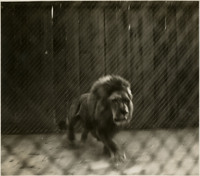 McCarthy Album 10, Photograph 033
McCarthy Album 10, Photograph 033 No Caption: An adult male African lion at Gay's Lion Farm in El Monte, Los Angeles, c. 1935.
-
McCarthy Album 10, Photograph 032
Image withheld due to copyright considerations. For more information, please contact the California State Archives Reference Desk at ArchivesWeb@sos.ca.gov or (916) 653-2246. No Caption: From a postcard of Gay's Lion Farm in El Monte showing Charles Gay riding "Pluto," an adult African Lion, c. 1935.
-
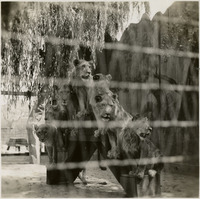 McCarthy Album 10, Photograph 031
McCarthy Album 10, Photograph 031 No Caption: Seven adult lions perform at Gay's Lion Farm in El Monte, Los Angeles, c. 1935.
-
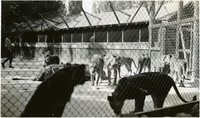 McCarthy Album 10, Photograph 030
McCarthy Album 10, Photograph 030 No Caption: Shows a group of adult African lions in a enclosed area of Gay's Lion Farm in El Monte, Los Angeles. Charles and Muriel Gay opened the farm in 1925 and operated it until 1942 as a popular tourist attraction where lions were selectively bred and trained for the Hollywood film industry. It was closed during WWII due to wartime meat shortages, and the lions were loaned to zoos around the country, c. 1935.
-
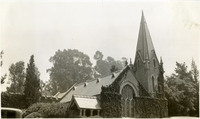 McCarthy Album 10, Photograph 029
McCarthy Album 10, Photograph 029 No Caption: Chapel at Forest Lawn Memorial Park, in Glendale, Los Angeles, c. 1935.
-
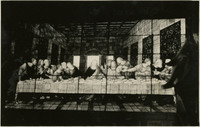 McCarthy Album 10, Photograph 028
McCarthy Album 10, Photograph 028 No Caption: " A stained glass reproduction of Leonardo da Vinci's Last Supper in the Memorial Court of Honor at Forest Lawn Memorial Park in Glendale, Los Angeles, c. 1935.
-
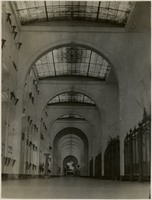 McCarthy Album 10, Photograph 027
McCarthy Album 10, Photograph 027 No Caption: Mausoleum at Forest Lawn Memorial Park in Glendale, Los Angeles, c. 1935.
-
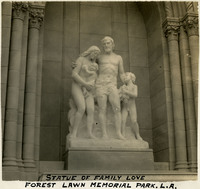 McCarthy Album 10, Photograph 026
McCarthy Album 10, Photograph 026 Caption: "Statue of Family Love, Forest Lawn Memorial Park. L.A.," c. 1935, shows Family Love (Ernesto Gazzeri, sculptor), on the grounds of Forest Lawn Memorial Park in Glendale, Los Angeles.
-
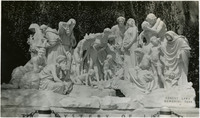 McCarthy Album 10, Photograph 025
McCarthy Album 10, Photograph 025 No Caption: A large marble sculpture, The Mystery of Life (Ernesto Gazzeri, sculptor), on the grounds of Forest Lawn Memorial Park in Glendale, Los Angeles, c. 1935.
-
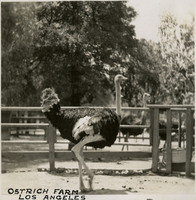 McCarthy Album 10, Photograph 024
McCarthy Album 10, Photograph 024 Caption: "Ostrich Farm, Los Angeles," c. 1935. View of several ostriches in a corral at the Cawston Ostrich Farm in Pasadena. Opened by Edward Cawston in 1886, this was the first ostrich farm in the U.S. It became a popular tourist stop along the Pasadena and Los Angeles Electric Railway in the early twentieth century, where visitors could ride an ostrich, or be pulled by one in a light card. They could also buy merchandise made out of ostrich feathers, such as hats and boas. The farm closed in the mid-1930s.
-
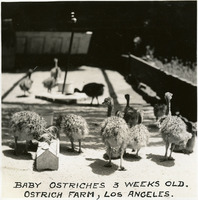 McCarthy Album 10, Photograph 023
McCarthy Album 10, Photograph 023 Caption: "Baby Ostriches 3 weeks old. Ostrich Farm, Los Angeles," c. 1935.
 McCarthy Album 10, Photograph 072 Caption: "Botanical Garden Building - San Diego Exposition," 1935, shows the Botanical Building and Conservatory with reflecting pool that featured lilies, begonias, fuchsias, and a variety of ferns at the California-Pacific International Exposition.
McCarthy Album 10, Photograph 072 Caption: "Botanical Garden Building - San Diego Exposition," 1935, shows the Botanical Building and Conservatory with reflecting pool that featured lilies, begonias, fuchsias, and a variety of ferns at the California-Pacific International Exposition. McCarthy Album 10, Photograph 071 Caption: "Colonades [sic] - San Diego Exposition," 1935.
McCarthy Album 10, Photograph 071 Caption: "Colonades [sic] - San Diego Exposition," 1935. McCarthy Album 10, Photograph 070 Caption: "Night Scene - San Diego Exposition," 1935, a night scene at San Diego's California-Pacific International Exposition shows the Arch of the Future with its multi-colored lights built within the Plaza del Pacifico.
McCarthy Album 10, Photograph 070 Caption: "Night Scene - San Diego Exposition," 1935, a night scene at San Diego's California-Pacific International Exposition shows the Arch of the Future with its multi-colored lights built within the Plaza del Pacifico. McCarthy Album 10, Photograph 069 Caption: "House of Charm - San Diego Exposition," 1935.
McCarthy Album 10, Photograph 069 Caption: "House of Charm - San Diego Exposition," 1935. McCarthy Album 10, Photograph 068 Caption: "Avenue of Palaces - San Diego Exposition," 1935.
McCarthy Album 10, Photograph 068 Caption: "Avenue of Palaces - San Diego Exposition," 1935. McCarthy Album 10, Photograph 067 Caption: "Mission-San Diego," c. 1935, shows Mission San Diego de Alcala, the first of twenty-one missions built by the Spanish Franciscans, and founded in 1769 by Father Junipero Serra.
McCarthy Album 10, Photograph 067 Caption: "Mission-San Diego," c. 1935, shows Mission San Diego de Alcala, the first of twenty-one missions built by the Spanish Franciscans, and founded in 1769 by Father Junipero Serra. McCarthy Album 10, Photograph 066 Caption: "Broadway San Diego, San Diego Population 160,000," c. 1935.
McCarthy Album 10, Photograph 066 Caption: "Broadway San Diego, San Diego Population 160,000," c. 1935. McCarthy Album 10, Photograph 065 Caption: "Pima Indian Children and their hut made from bush branches, Sacaton Indian Reservation, Sacaton, Arizona," c. 1935. Located south of Phoenix and including the town of Sacaton, the Gila River Indian Reservation is home to members of the Akimel O’odham (Pima) and the Pee-Posh (Maricopa) tribes. The reservation was established in 1859. Eighty years later, in 1939, Congress provided for the self-governance of the reservation via the Gila River Indian Community.
McCarthy Album 10, Photograph 065 Caption: "Pima Indian Children and their hut made from bush branches, Sacaton Indian Reservation, Sacaton, Arizona," c. 1935. Located south of Phoenix and including the town of Sacaton, the Gila River Indian Reservation is home to members of the Akimel O’odham (Pima) and the Pee-Posh (Maricopa) tribes. The reservation was established in 1859. Eighty years later, in 1939, Congress provided for the self-governance of the reservation via the Gila River Indian Community. McCarthy Album 10, Photograph 064 Caption: "Pima Indian Children and their hut made from bush branches, Sacaton Indian Reservation, Sacaton, Arizona," c. 1935. Located south of Phoenix and including the town of Sacaton, the Gila River Indian Reservation is home to members of the Akimel O’odham (Pima) and the Pee-Posh (Maricopa) tribes. The reservation was established in 1859. Eighty years later, in 1939, Congress provided for the self-governance of the reservation via the Gila River Indian Community.
McCarthy Album 10, Photograph 064 Caption: "Pima Indian Children and their hut made from bush branches, Sacaton Indian Reservation, Sacaton, Arizona," c. 1935. Located south of Phoenix and including the town of Sacaton, the Gila River Indian Reservation is home to members of the Akimel O’odham (Pima) and the Pee-Posh (Maricopa) tribes. The reservation was established in 1859. Eighty years later, in 1939, Congress provided for the self-governance of the reservation via the Gila River Indian Community. McCarthy Album 10, Photograph 063 Caption: "Indian Hut Made from Adobe and Bush Branches, Sacaton Indian Reservation - Sacaton, Arizona," c. 1935. View of a small adobe building with a porch area across the length of the façade. The porch is sheltered by a low roof supported by tree trunks or thick tree branches and thatched with grass or sticks. Located south of Phoenix and including the town of Sacaton, the Gila River Indian Reservation is home to members of the Akimel O’odham (Pima) and the Pee-Posh (Maricopa) tribes. The reservation was established in 1859. Eighty years later, in 1939, Congress provided for the self-governance of the reservation via the Gila River Indian Community.
McCarthy Album 10, Photograph 063 Caption: "Indian Hut Made from Adobe and Bush Branches, Sacaton Indian Reservation - Sacaton, Arizona," c. 1935. View of a small adobe building with a porch area across the length of the façade. The porch is sheltered by a low roof supported by tree trunks or thick tree branches and thatched with grass or sticks. Located south of Phoenix and including the town of Sacaton, the Gila River Indian Reservation is home to members of the Akimel O’odham (Pima) and the Pee-Posh (Maricopa) tribes. The reservation was established in 1859. Eighty years later, in 1939, Congress provided for the self-governance of the reservation via the Gila River Indian Community. McCarthy Album 10, Photograph 062 Caption: "Central Street, Phoenix, Arizona, Phoenix Population 51,000," c. 1935 shows a busy street scene in Phoenix, Arizona.
McCarthy Album 10, Photograph 062 Caption: "Central Street, Phoenix, Arizona, Phoenix Population 51,000," c. 1935 shows a busy street scene in Phoenix, Arizona. McCarthy Album 10, Photograph 061 Caption: "Pueblo Indians at Hopi House, Indian War Dance-Arizona Grand Canyon," c. 1935
McCarthy Album 10, Photograph 061 Caption: "Pueblo Indians at Hopi House, Indian War Dance-Arizona Grand Canyon," c. 1935 McCarthy Album 10, Photograph 060 No Caption: A view of the Grand Canyon, c. 1935.
McCarthy Album 10, Photograph 060 No Caption: A view of the Grand Canyon, c. 1935. McCarthy Album 10, Photograph 059 Caption: "Arizona Grand Canyon and Colorado River," c. 1935.
McCarthy Album 10, Photograph 059 Caption: "Arizona Grand Canyon and Colorado River," c. 1935. McCarthy Album 10, Photograph 058 Caption: "Puablo [sic] Indian Mother and Child, Arizona Grand Canyon," c. 1935, shows a Pueblo Indian mother with three children.
McCarthy Album 10, Photograph 058 Caption: "Puablo [sic] Indian Mother and Child, Arizona Grand Canyon," c. 1935, shows a Pueblo Indian mother with three children. McCarthy Album 10, Photograph 057 Caption: "Arizona Grand Canyon and Colorado River," c. 1935.
McCarthy Album 10, Photograph 057 Caption: "Arizona Grand Canyon and Colorado River," c. 1935. McCarthy Album 10, Photograph 056 Caption: "At Desert View Tower Arizona Grand Canyon," c. 1935, shows Grace and William McCarthy at the top of the Desert View Watchtower.
McCarthy Album 10, Photograph 056 Caption: "At Desert View Tower Arizona Grand Canyon," c. 1935, shows Grace and William McCarthy at the top of the Desert View Watchtower. McCarthy Album 10, Photograph 055 Caption: "Desert View Arizona Grand Canyon," c. 1935, shows William and Grace McCarthy looking out over the Grand Canyon from the top of the Desert View Watchtower.
McCarthy Album 10, Photograph 055 Caption: "Desert View Arizona Grand Canyon," c. 1935, shows William and Grace McCarthy looking out over the Grand Canyon from the top of the Desert View Watchtower. McCarthy Album 10, Photograph 054 Caption: "Arizona Grand Canyon," c. 1935.
McCarthy Album 10, Photograph 054 Caption: "Arizona Grand Canyon," c. 1935. McCarthy Album 10, Photograph 053 Caption: "Desert View Tower - Arizona Grand Canyon," c. 1935. The Desert View Watchtower, built in 1932, was designed by architect Mary Colter in the style of Ancestral Puebloan watchtowers.
McCarthy Album 10, Photograph 053 Caption: "Desert View Tower - Arizona Grand Canyon," c. 1935. The Desert View Watchtower, built in 1932, was designed by architect Mary Colter in the style of Ancestral Puebloan watchtowers. McCarthy Album 10, Photograph 052 Caption: "Tourist Camp Grounds-Arizona Grand Canyon," c. 1935, shows Grace McCarthy standing near an automobile at a Grand Canyon campground.
McCarthy Album 10, Photograph 052 Caption: "Tourist Camp Grounds-Arizona Grand Canyon," c. 1935, shows Grace McCarthy standing near an automobile at a Grand Canyon campground. McCarthy Album 10, Photograph 051 Caption: "Hermits Rest - Grand Canyon of Arizona," c. 1935, shows Grace McCarthy sitting under an archway made of large boulders, with a bell hanging down from the top center, and "Hermits Rest" spelled out on one of the rocks.
McCarthy Album 10, Photograph 051 Caption: "Hermits Rest - Grand Canyon of Arizona," c. 1935, shows Grace McCarthy sitting under an archway made of large boulders, with a bell hanging down from the top center, and "Hermits Rest" spelled out on one of the rocks. McCarthy Album 10, Photograph 050 Caption: "Arizona Grand Canyon," c. 1935.
McCarthy Album 10, Photograph 050 Caption: "Arizona Grand Canyon," c. 1935. McCarthy Album 10, Photograph 049 Caption: "Salome Arizona, Giant Cactus or Desert Sentinels - Arizona Desert. June 1, 1935."
McCarthy Album 10, Photograph 049 Caption: "Salome Arizona, Giant Cactus or Desert Sentinels - Arizona Desert. June 1, 1935." McCarthy Album 10, Photograph 048 Caption: "Cactus in Bloom Near Phoenix, Arizona," c. 1935, shows a large cactus in bloom and a bull resting nearby.
McCarthy Album 10, Photograph 048 Caption: "Cactus in Bloom Near Phoenix, Arizona," c. 1935, shows a large cactus in bloom and a bull resting nearby. McCarthy Album 10, Photograph 047 No Caption: A Joshua tree in bloom in the Arizona desert, c. 1935.
McCarthy Album 10, Photograph 047 No Caption: A Joshua tree in bloom in the Arizona desert, c. 1935. McCarthy Album 10, Photograph 046 Caption: "Giant Cactus Arizona Desert, Salome, AR. June 1, 1935," shows William McCarthy standing next to a large cactus at Salome, Arizona.
McCarthy Album 10, Photograph 046 Caption: "Giant Cactus Arizona Desert, Salome, AR. June 1, 1935," shows William McCarthy standing next to a large cactus at Salome, Arizona. McCarthy Album 10, Photograph 045 Caption: "Colorado River at Blythe, Calif. May 31, 1935."
McCarthy Album 10, Photograph 045 Caption: "Colorado River at Blythe, Calif. May 31, 1935." McCarthy Album 10, Photograph 044 Caption: "Tree Bareing [sic] 8 Varieties of Fruit. Shields Date Gardens - Blythe, Calif. May 31, 1935," shows William McCarthy standing next to a tree that bears eight varieties of fruit.
McCarthy Album 10, Photograph 044 Caption: "Tree Bareing [sic] 8 Varieties of Fruit. Shields Date Gardens - Blythe, Calif. May 31, 1935," shows William McCarthy standing next to a tree that bears eight varieties of fruit. McCarthy Album 10, Photograph 043 Caption: "Date Palm, Shields Date Gardens, Blythe, California, May 31, 1935," shows Grace McCarthy standing next to a date palm.
McCarthy Album 10, Photograph 043 Caption: "Date Palm, Shields Date Gardens, Blythe, California, May 31, 1935," shows Grace McCarthy standing next to a date palm. McCarthy Album 10, Photograph 042 Caption: "Shields Date Gardens - Coachella Valley, Blythe, Calif. May 31, 1935." Date Palms at the Shields Date Gardens, which opened in 1924 at Blythe, California.
McCarthy Album 10, Photograph 042 Caption: "Shields Date Gardens - Coachella Valley, Blythe, Calif. May 31, 1935." Date Palms at the Shields Date Gardens, which opened in 1924 at Blythe, California. McCarthy Album 10, Photograph 041 Caption: "Orocopia Mountains Near Mecca, Calif. May 30, 1935," shows an empty road traversing the Orocopia Mountains near Mecca, in Riverside County.
McCarthy Album 10, Photograph 041 Caption: "Orocopia Mountains Near Mecca, Calif. May 30, 1935," shows an empty road traversing the Orocopia Mountains near Mecca, in Riverside County. McCarthy Album 10, Photograph 040 Caption: "El Mirado Hotel-Palm Springs, Calif. May 30, 1935." The Spanish Colonial-Revival style El Mirado Hotel at Palm Springs opened in 1927 and became one of the most fashionable resort destinations for powerful Hollywood studio heads and celebrities. Here Grace is seen posing at the edge of the hotel's famous "plunge."
McCarthy Album 10, Photograph 040 Caption: "El Mirado Hotel-Palm Springs, Calif. May 30, 1935." The Spanish Colonial-Revival style El Mirado Hotel at Palm Springs opened in 1927 and became one of the most fashionable resort destinations for powerful Hollywood studio heads and celebrities. Here Grace is seen posing at the edge of the hotel's famous "plunge." McCarthy Album 10, Photograph 039 Caption: "El Mirado Hotel-Palm Springs, Calif. May 30, 1935." The Spanish Colonial-Revival style El Mirado Hotel at Palm Springs opened in 1927 and became one of the most fashionable resort destinations for powerful Hollywood studio heads and celebrities.
McCarthy Album 10, Photograph 039 Caption: "El Mirado Hotel-Palm Springs, Calif. May 30, 1935." The Spanish Colonial-Revival style El Mirado Hotel at Palm Springs opened in 1927 and became one of the most fashionable resort destinations for powerful Hollywood studio heads and celebrities. McCarthy Album 10, Photograph 038 Caption: "Orange Grove - Foothill Blvd. San Bernardino, May 30, 1935." Shows an orange grove behind a row of stately palms on Foothill Blvd., also known as Route 66.
McCarthy Album 10, Photograph 038 Caption: "Orange Grove - Foothill Blvd. San Bernardino, May 30, 1935." Shows an orange grove behind a row of stately palms on Foothill Blvd., also known as Route 66. McCarthy Album 10, Photograph 037 Caption: "Bobs Service Station - Wilshire Blvd. Los Angeles," c. 1935, shows Bob Spencer's Mobil gas service station, which was built around a grounded Fokker F32, whose wings served as a canopy for the fueling stations.
McCarthy Album 10, Photograph 037 Caption: "Bobs Service Station - Wilshire Blvd. Los Angeles," c. 1935, shows Bob Spencer's Mobil gas service station, which was built around a grounded Fokker F32, whose wings served as a canopy for the fueling stations. McCarthy Album 10, Photograph 036 Caption: "Wilshirmart - Corner Wilshire Blvd. and Doheny Drive. Los Angeles is Noted for its Excellent Produce Markets," c. 1935.
McCarthy Album 10, Photograph 036 Caption: "Wilshirmart - Corner Wilshire Blvd. and Doheny Drive. Los Angeles is Noted for its Excellent Produce Markets," c. 1935. McCarthy Album 10, Photograph 035 Caption: "Aimee McPherson's Angeles Temple- Los Angeles," c. 1935. Aimee Semple McPherson, also known as Sister Aimee was a Canadian-American Pentecostal evangelist and media celebrity in the 1920s and 1930s, famous for her theatrical sermons and claims of healing the sick, and for founding the Foursquare Church.
McCarthy Album 10, Photograph 035 Caption: "Aimee McPherson's Angeles Temple- Los Angeles," c. 1935. Aimee Semple McPherson, also known as Sister Aimee was a Canadian-American Pentecostal evangelist and media celebrity in the 1920s and 1930s, famous for her theatrical sermons and claims of healing the sick, and for founding the Foursquare Church. McCarthy Album 10, Photograph 034 No Caption: Shows an unidentified pond or lake in a Los Angeles area park, c. 1935.
McCarthy Album 10, Photograph 034 No Caption: Shows an unidentified pond or lake in a Los Angeles area park, c. 1935. McCarthy Album 10, Photograph 033 No Caption: An adult male African lion at Gay's Lion Farm in El Monte, Los Angeles, c. 1935.
McCarthy Album 10, Photograph 033 No Caption: An adult male African lion at Gay's Lion Farm in El Monte, Los Angeles, c. 1935. McCarthy Album 10, Photograph 031 No Caption: Seven adult lions perform at Gay's Lion Farm in El Monte, Los Angeles, c. 1935.
McCarthy Album 10, Photograph 031 No Caption: Seven adult lions perform at Gay's Lion Farm in El Monte, Los Angeles, c. 1935. McCarthy Album 10, Photograph 030 No Caption: Shows a group of adult African lions in a enclosed area of Gay's Lion Farm in El Monte, Los Angeles. Charles and Muriel Gay opened the farm in 1925 and operated it until 1942 as a popular tourist attraction where lions were selectively bred and trained for the Hollywood film industry. It was closed during WWII due to wartime meat shortages, and the lions were loaned to zoos around the country, c. 1935.
McCarthy Album 10, Photograph 030 No Caption: Shows a group of adult African lions in a enclosed area of Gay's Lion Farm in El Monte, Los Angeles. Charles and Muriel Gay opened the farm in 1925 and operated it until 1942 as a popular tourist attraction where lions were selectively bred and trained for the Hollywood film industry. It was closed during WWII due to wartime meat shortages, and the lions were loaned to zoos around the country, c. 1935. McCarthy Album 10, Photograph 029 No Caption: Chapel at Forest Lawn Memorial Park, in Glendale, Los Angeles, c. 1935.
McCarthy Album 10, Photograph 029 No Caption: Chapel at Forest Lawn Memorial Park, in Glendale, Los Angeles, c. 1935. McCarthy Album 10, Photograph 028 No Caption: " A stained glass reproduction of Leonardo da Vinci's Last Supper in the Memorial Court of Honor at Forest Lawn Memorial Park in Glendale, Los Angeles, c. 1935.
McCarthy Album 10, Photograph 028 No Caption: " A stained glass reproduction of Leonardo da Vinci's Last Supper in the Memorial Court of Honor at Forest Lawn Memorial Park in Glendale, Los Angeles, c. 1935. McCarthy Album 10, Photograph 027 No Caption: Mausoleum at Forest Lawn Memorial Park in Glendale, Los Angeles, c. 1935.
McCarthy Album 10, Photograph 027 No Caption: Mausoleum at Forest Lawn Memorial Park in Glendale, Los Angeles, c. 1935. McCarthy Album 10, Photograph 026 Caption: "Statue of Family Love, Forest Lawn Memorial Park. L.A.," c. 1935, shows Family Love (Ernesto Gazzeri, sculptor), on the grounds of Forest Lawn Memorial Park in Glendale, Los Angeles.
McCarthy Album 10, Photograph 026 Caption: "Statue of Family Love, Forest Lawn Memorial Park. L.A.," c. 1935, shows Family Love (Ernesto Gazzeri, sculptor), on the grounds of Forest Lawn Memorial Park in Glendale, Los Angeles. McCarthy Album 10, Photograph 025 No Caption: A large marble sculpture, The Mystery of Life (Ernesto Gazzeri, sculptor), on the grounds of Forest Lawn Memorial Park in Glendale, Los Angeles, c. 1935.
McCarthy Album 10, Photograph 025 No Caption: A large marble sculpture, The Mystery of Life (Ernesto Gazzeri, sculptor), on the grounds of Forest Lawn Memorial Park in Glendale, Los Angeles, c. 1935. McCarthy Album 10, Photograph 024 Caption: "Ostrich Farm, Los Angeles," c. 1935. View of several ostriches in a corral at the Cawston Ostrich Farm in Pasadena. Opened by Edward Cawston in 1886, this was the first ostrich farm in the U.S. It became a popular tourist stop along the Pasadena and Los Angeles Electric Railway in the early twentieth century, where visitors could ride an ostrich, or be pulled by one in a light card. They could also buy merchandise made out of ostrich feathers, such as hats and boas. The farm closed in the mid-1930s.
McCarthy Album 10, Photograph 024 Caption: "Ostrich Farm, Los Angeles," c. 1935. View of several ostriches in a corral at the Cawston Ostrich Farm in Pasadena. Opened by Edward Cawston in 1886, this was the first ostrich farm in the U.S. It became a popular tourist stop along the Pasadena and Los Angeles Electric Railway in the early twentieth century, where visitors could ride an ostrich, or be pulled by one in a light card. They could also buy merchandise made out of ostrich feathers, such as hats and boas. The farm closed in the mid-1930s. McCarthy Album 10, Photograph 023 Caption: "Baby Ostriches 3 weeks old. Ostrich Farm, Los Angeles," c. 1935.
McCarthy Album 10, Photograph 023 Caption: "Baby Ostriches 3 weeks old. Ostrich Farm, Los Angeles," c. 1935.